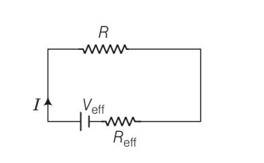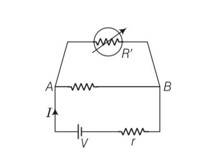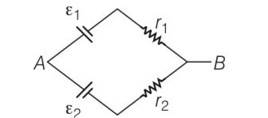Physics NCERT Exemplar Solutions Class 12th Chapter Three
Get insights from 68 questions on Physics NCERT Exemplar Solutions Class 12th Chapter Three, answered by students, alumni, and experts. You may also ask and answer any question you like about Physics NCERT Exemplar Solutions Class 12th Chapter Three
Follow Ask QuestionQuestions
Discussions
Active Users
Followers
New answer posted
5 months agoContributor-Level 10
This is a Multiple Choice Questions as classified in NCERT Exemplar
Answer – (a, d)
Explanation- potential drop across AB is independent to R' also when we decrease the value of R the current will also very large. According to the relation I=e/R+r
New answer posted
5 months agoContributor-Level 10
This is a Multiple Choice Questions as classified in NCERT Exemplar
Answer – (b, d)
Explanation-Algebraic sum of the currents flowing towards any point in an electric network is zero. It also tell us about the conservation of charge.
New answer posted
5 months agoContributor-Level 10
This is a Multiple Choice Questions as classified in NCERT Exemplar
Answer- (a)
Explanation- I=AneVd , current is directly proportional to drift velocity.
New answer posted
5 months agoContributor-Level 10
This is a Multiple Choice Questions as classified in NCERT Exemplar
Answer- (a)
Explanation- R= for greater value of R, A should be less and its possible value when connected across 1cm 1/2cm faces.
New answer posted
5 months agoContributor-Level 10
This is a Multiple Choice Questions as classified in NCERT Exemplar
Answer- (b)
Explanation-The potential drop along the wires of potentiometer should be greater than emfs of cells.
In a potentiometer experiment, the emf of a cell can be measured if the potential drop along the potentiometer wire is more than the emf of the cell to be determined. Here, values of emfs of two cells are given as 5 V and 10 V, therefore, the potential drop along the potentiometer wire must be more than 10 V.
New answer posted
5 months agoContributor-Level 10
This is a Multiple Choice Questions as classified in NCERT Exemplar
Answer – (c)
Explanation – R/S= (l1/100-l1)= 100 (2.9/100-2.9)= 100/97.1=2.98ohm
So he should change S to almost 3 ohm and repeat the experiment.
New answer posted
5 months agoContributor-Level 10
This is a Multiple Choice Questions as classified in NCERT Exemplar
Answer- (a)
Explanation- eeq=
New answer posted
5 months agoContributor-Level 10
This is a Multiple Choice Questions as classified in NCERT Exemplar
Answer- (b)
Explanation- as we know that J=E, and current density is directly proportional to electric field, so electric field produced by charges accumulated on the surface of wire.
New answer posted
5 months agoContributor-Level 10
This is a Short Answer Type Questions as classified in NCERT Exemplar
Explanation- according to ohms law
I=

If voltage and resistance increase
V'= nVeff, R'= nReff
I'= =
New answer posted
5 months agoContributor-Level 10
This is a Short Answer Type Questions as classified in NCERT Exemplar
Explanation- R= /A
Resistance of first conductor, RA= 2
Resistance of second conductor, RB=
Now ratio = 3:1
Taking an Exam? Selecting a College?
Get authentic answers from experts, students and alumni that you won't find anywhere else
Sign Up on ShikshaOn Shiksha, get access to
- 65k Colleges
- 1.2k Exams
- 679k Reviews
- 1800k Answers


